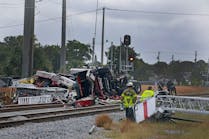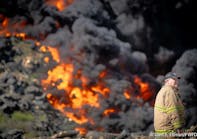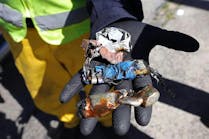Buildings On Fire: Building Anatomy: Types and Classifications
Today’s evolving fireground demands a greater understanding of buildings, occupancy risk profiling (ORP) and building anatomy by all companies operating on the fireground. The identification, assessment, probability, predictability and intrinsic characteristics of building performance under fire conditions must not only be comprehended, but postulated into an adaptive fire-management model and flexible Incident Action Plan (IAP).
Building types and classifications are formulative toward anticipating variables in structural integrity and resiliency to the effects of extreme fire behavior, accelerated fire-load package growth rates and intensity levels during initial and sustained fire suppression. Understanding the construction and uses of a building is integral to effective and efficient firefighting operations and essential for all phases of combat fire engagement and suppression. Examining key insights into the manner in which buildings have been traditionally classified from a construction and code-compliance perspective will lead us to challenge today’s conventional wisdom.
NFPA 220: Standard on Types of Building Construction, 2012 edition, promulgated and published by the National Fire Protection Association (NFPA), defines standard types of building construction based on the combustibility and the fire-resistance rating of a building’s structural elements. Fire walls, non-bearing exterior walls, non-bearing interior partitions, fire barrier walls, shaft enclosures and openings in walls, partitions, floors and roofs are not related to the types of building construction and are regulated by other standards and codes, where appropriate.
Insights and history
• In 1952, the NFPA Committee on Building Construction secured tentative adoption of NFPA 220, Standard on Types of Building Construction, with subsequent revisions in 1954 and 1955. The definition of non-combustibility and editorial changes in the description of the fire resistance rating of structural members (under the definition of fire-resistive construction) were first adopted in 1956.
• In 1958, with the development of the use of plastics in building construction, recommendations on the types of standard fire tests to be used in evaluating the fire safety of these materials were first adopted.
• In 1975, a more fundamental definition of non-combustible was added, including the introduction of a definition of limited-combustible, based on potential heat value limitations and more generalized definitions for types of building construction.
• In 1979, the standard was extensively rewritten to introduce the nomenclature related to construction Type I through Type V, which included parenthetically placed hourly fire-resistance designations of the structural components.
Conventional building types
Buildings and structures are commonly classified according to their type of construction based on one of five basic types:
• Type I (or Type 1) – Commonly referred to as fire-resistive construction
• Type II (or Type 2) – Commonly referred to as non-combustible construction
• Type III (or Type 3) – Commonly referred to as ordinary construction
• Type IV (or Type 4) – Commonly referred to as heavy-timber construction
• Type V (or Type 5) – Commonly referred to as wood-frame construction
Variations include the use of the terms Class I, II, III, IV and V. Refer to NFPA 220, 2012 edition, Table 4.1.1 for additional insights and details related to fire-resistive ratings (hours) for exterior bearing walls, interior bearing walls, columns, beams, girders, trusses and arches, floor-ceiling assemblies, roof-ceiling assemblies, interior non-bearing walls and exterior non-bearing walls.
This system of designating types of construction also breaks down types of construction through the use of arabic numbers; e.g., Type I(442), Type II(111), Type III(200) – and indicate the fire-resistance rating requirements for certain structural elements:
1. First arabic number – Exterior bearing walls
2. Second arabic number – Columns, beams, girders, trusses and arches, supporting bearing walls, columns or loads from more than one floor
3. Third arabic number – Floors
Type I. Fire resistive. In this type of construction the structural elements consist of non-combustible materials, usually steel or concrete, that afford a fire-resistance rating that provides a given fire protection performance endurance against the effects of fire.
• These specific ratings are determined by the model building codes for a specific type of construction
• These specific ratings apply to the roof and floor assemblies as well as any exterior or interior bearing support walls
• Interior partitions are required to be constructed with approved non-combustible materials
• The fire-resistance ratings are provided by different designs that meet minimum performance
Type II: Non-combustible. The same requirements that apply to Type I construction also apply to this type of construction, with some differences.
• This type of construction may not afford any fire-resistance rating for the exposed structural elements
• If any fire protection of the structural elements is provided, it is at a lesser rating than that required for Type I construction; in this type of building the structural elements are usually made of steel, bolted, riveted or welded together
• This type of construction is susceptible to expansion, distortion or relaxation of the steel members, resulting in early collapse during a fire
• Again, interior partitions are required to be constructed with non-combustible or approved limited-combustible materials
Type III: Ordinary. In this construction type, all or part of the interior structural elements may be combustible. Exterior walls are required to be constructed with non-combustible materials. They can have a fire-resistance rating, depending on the horizontal separation and whether they are bearing or non-bearing walls.
• This category usually is divided into protected and unprotected subtypes; the building will have masonry exterior walls and wooden structural members and combustible interior construction
• The building generally will not exceed six stories and most often will be two or three stories in height
• Floor and roof supports are usually wood, but other materials, such as steel bar joists, may be found
• Floor and roof decking most frequently will be plywood or composition board
• Common walls between buildings may share wall sockets for floor joists and roof rafters
Type IV: Heavy timber. Heavy-timber structural members – columns, beams, arches, floors and roofs – are unprotected wood with large cross-sectional areas.
• A minimum dimension of eight inches for structural wood supports (columns, beams, arches and girders) is required
• All other exposed wood must have a minimum dimension of two inches; concealed spaces usually are not permitted
• These buildings consist of masonry (non-combustible) exterior walls and structural members of substantial timber construction
• Commonly, this type of construction is found in older factories and mills; however, there is a resurgence in their use in various new occupancy types
• Wood floors generally will have a minimum thickness of three inches and may be oil-soaked from years of oiling heavy machinery
• Roof supports will be wood with minimum dimensions of four by six inches, and a minimum roof decking thickness of 11/8 inches
Type V: Wood frame/combustible. This type of construction uses structural members entirely of combustible materials, usually wood, and is divided into two subgroups: protected (structural elements protected as required) or unprotected (no fire-resistance requirement).
• Post-and-beam construction has a wood frame of substantial dimension and is sided with a lightweight covering such as wood boards or plywood covered with aluminum or PVC siding; this type of construction is commonly used for barns, sheds and other storage buildings, but also may occur in dwellings and other occupancies
• In balloon-frame construction studs run from the foundation to the attic (This type of construction was common in many parts of the country until the late 1930s for residential and light commercial buildings. This provides a continuous air space from top to bottom. Floor joists are tied into the wall, allowing for fire extension in any direction. Fire stopping was not a common practice.)
• In platform-frame construction the walls of each successive story are built on a platform formed by the preceding floor (The joists for the deck may be full-dimension lumber or lightweight materials. Once the floor or deck is in place, walls are placed on it with a sill at the bottom of the wall and a plate at the top. Platform-frame construction provides a natural fire barrier for vertical extension within the walls, but openings in walls for water, sewer, ventilation or heating/air conditioning pipes can create a void for fire extension.)
• Modern construction uses assemblies and structural systems comprised of engineered components with a continuing advancement of new materials, designs and structural and architectural integration.
Strategies and tactics
Since the late 1940s, the fire service has used building-type classifications to define or establish prescribed strategic or tactical deployment methods based on predictability of fireground and building performance. The fire service used to discern, with some predictability, how certain building types would perform under most fire conditions. Implementing established fundamentals of firefighting operations built on nine decades of proven strategies and tactics has formulated today’s conventional models of fire suppression operations. These same fundamental strategies related to building types continue to drive methodologies and operational curricula that are the core of modern fire suppression theory and combat fire engagement in the built environment.
The evolving and rapidly changing dynamics of building structures and occupancies involve new construction as well as renovation and adaptive reuse of older buildings and occupancies. The fire service must re-examine operations related to construction types and create a new order of building classifications and groupings to help fire departments meet the challenges faced on today’s fireground. n
Christopher J. Naum will present “Reading the Building: Predictive Occupancy Profiling” at Firehouse Expo 2012, July 17-21 in Baltimore, MD.
CHRISTOPHER J. NAUM, SFPE, a Firehouse® contributing editor, is a 36-year fire service veteran and a national instructor, author and lecturer. He is an authority on building construction issues affecting the fire and emergency services and a former fire command officer, architect and fire protection engineer. Naum is a technical reviewer to the NIOSH firefighter fatality investigation and prevention program and NFFF Firefighter Safety Advocate. Naum is the executive producer of buildingsonfire.com, a site dedicated to building construction, fire command and firefighter safety. He can be contacted at [email protected] or at buildingsonfire.com. For expanded articles, follow his blog at Firehouse.com and on Facebook at Buildingsonfire.
Suggestions for New Building Anatomy Categories
Recently, there has been a movement based on emerging research and analysis that has categorized buildings into two groups: engineered and legacy construction. I believe this is far too limiting and restrictive, which is resulting in missed opportunities to develop further insights into other building-type systems and occupancy risk profiling related to adaptive fireground management and operations. To refine categories that provide corresponding values related to inherent construction features, systems, collapse, performance characteristics, fire integrity, resistance, etc., the following Building Anatomy Construction Systems are suggested:
• Heritage Construction (HC) – Pre-1900
• Legacy Construction (LC) – 1900-1949
• Conventional Construction (CC) – 1950-1979
• Engineered Structural Systems (ESS) – 1980 to present
• Integrated Hybrid Construction Systems (IHS) – 2002 to present
• Composite Engineered Construction Systems (CES) – 2010 to present
Look for expanded narratives and definitions on these suggested Building Anatomy Construction Systems and categories on Firehouse.com and Buildingsonfire.com. We will also address fundamental fire service operational insights related to conventional building types and to these new categories and how they may aid today’s fireground operations.
—Christopher J. Naum






